Tesco's Business Strategy: Macro Environment and Internal Analysis
VerifiedAdded on 2023/01/13
|12
|3411
|28
Report
AI Summary
This report provides a comprehensive analysis of Tesco's business strategy, focusing on the impact of the macro environment and internal factors. It covers key elements such as VRIO analysis, Porter's Five Forces model, and the Ansoff matrix to assess Tesco's competitive position and strategic planning. The report delves into Tesco's vision, mission, objectives, and strategic planning techniques, including budget planning, business analysis, market analysis, and stakeholder analysis. It critically analyzes the macro environment, internal resources, and competitive landscape, highlighting Tesco's strengths, weaknesses, opportunities, and threats. The document also discusses the application of the McKinsey 7S model for internal alignment and strategic management planning. Desklib offers a wealth of similar solved assignments and study resources for students.

Business Strategy
Paraphrase This Document
Need a fresh take? Get an instant paraphrase of this document with our AI Paraphraser
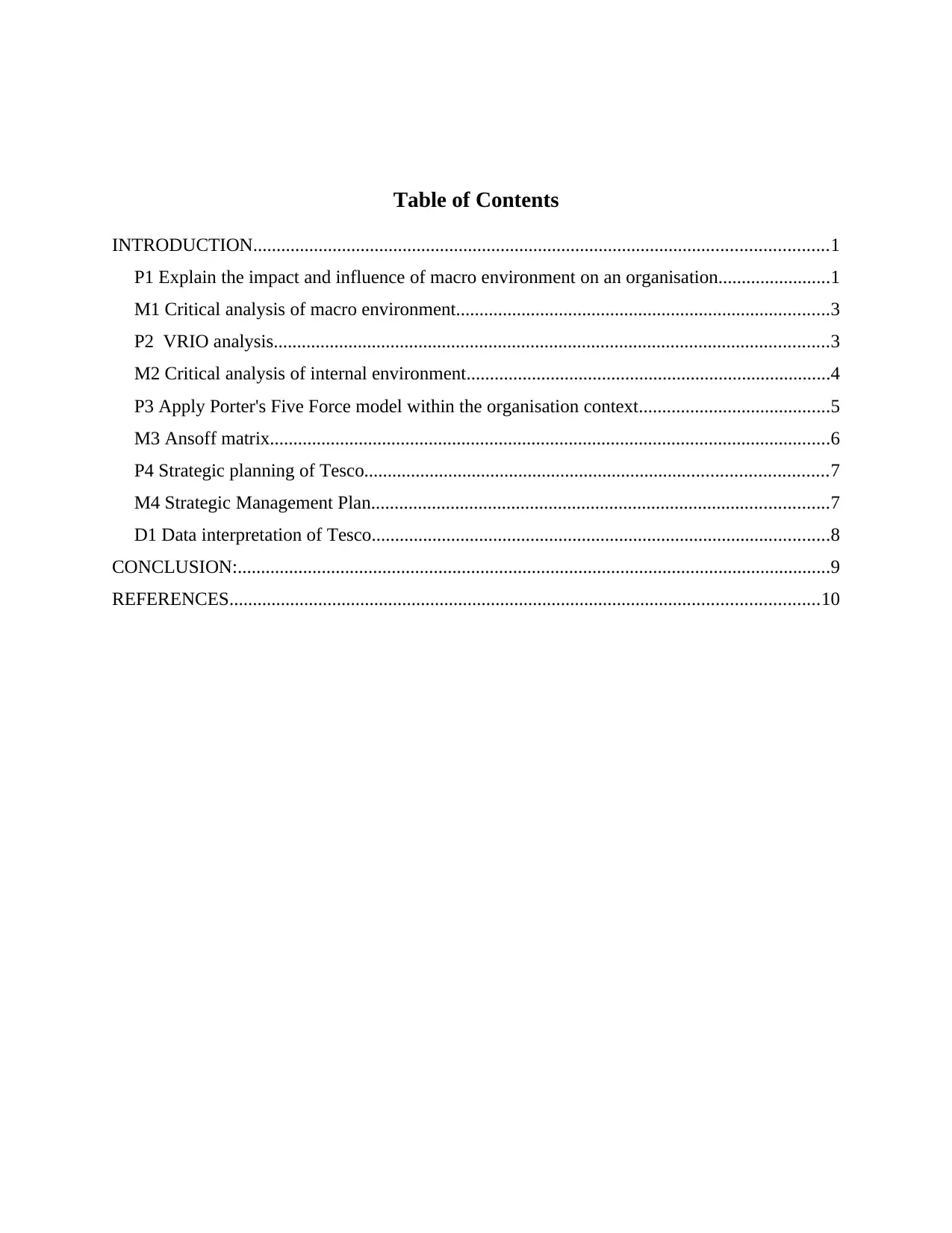
Table of Contents
INTRODUCTION...........................................................................................................................1
P1 Explain the impact and influence of macro environment on an organisation........................1
M1 Critical analysis of macro environment................................................................................3
P2 VRIO analysis.......................................................................................................................3
M2 Critical analysis of internal environment..............................................................................4
P3 Apply Porter's Five Force model within the organisation context.........................................5
M3 Ansoff matrix........................................................................................................................6
P4 Strategic planning of Tesco...................................................................................................7
M4 Strategic Management Plan..................................................................................................7
D1 Data interpretation of Tesco..................................................................................................8
CONCLUSION:...............................................................................................................................9
REFERENCES..............................................................................................................................10
INTRODUCTION...........................................................................................................................1
P1 Explain the impact and influence of macro environment on an organisation........................1
M1 Critical analysis of macro environment................................................................................3
P2 VRIO analysis.......................................................................................................................3
M2 Critical analysis of internal environment..............................................................................4
P3 Apply Porter's Five Force model within the organisation context.........................................5
M3 Ansoff matrix........................................................................................................................6
P4 Strategic planning of Tesco...................................................................................................7
M4 Strategic Management Plan..................................................................................................7
D1 Data interpretation of Tesco..................................................................................................8
CONCLUSION:...............................................................................................................................9
REFERENCES..............................................................................................................................10
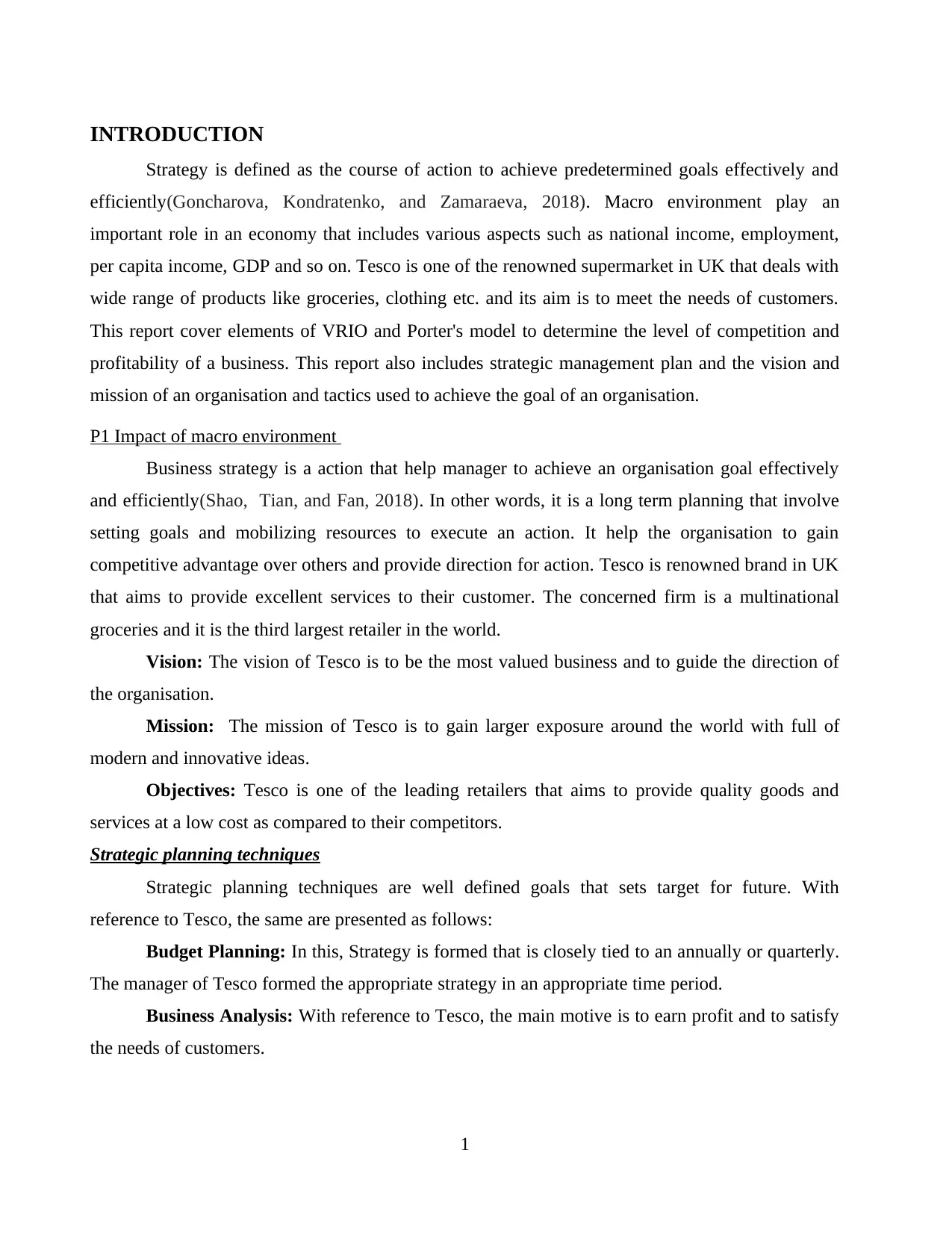
INTRODUCTION
Strategy is defined as the course of action to achieve predetermined goals effectively and
efficiently(Goncharova, Kondratenko, and Zamaraeva, 2018). Macro environment play an
important role in an economy that includes various aspects such as national income, employment,
per capita income, GDP and so on. Tesco is one of the renowned supermarket in UK that deals with
wide range of products like groceries, clothing etc. and its aim is to meet the needs of customers.
This report cover elements of VRIO and Porter's model to determine the level of competition and
profitability of a business. This report also includes strategic management plan and the vision and
mission of an organisation and tactics used to achieve the goal of an organisation.
P1 Impact of macro environment
Business strategy is a action that help manager to achieve an organisation goal effectively
and efficiently(Shao, Tian, and Fan, 2018). In other words, it is a long term planning that involve
setting goals and mobilizing resources to execute an action. It help the organisation to gain
competitive advantage over others and provide direction for action. Tesco is renowned brand in UK
that aims to provide excellent services to their customer. The concerned firm is a multinational
groceries and it is the third largest retailer in the world.
Vision: The vision of Tesco is to be the most valued business and to guide the direction of
the organisation.
Mission: The mission of Tesco is to gain larger exposure around the world with full of
modern and innovative ideas.
Objectives: Tesco is one of the leading retailers that aims to provide quality goods and
services at a low cost as compared to their competitors.
Strategic planning techniques
Strategic planning techniques are well defined goals that sets target for future. With
reference to Tesco, the same are presented as follows:
Budget Planning: In this, Strategy is formed that is closely tied to an annually or quarterly.
The manager of Tesco formed the appropriate strategy in an appropriate time period.
Business Analysis: With reference to Tesco, the main motive is to earn profit and to satisfy
the needs of customers.
1
Strategy is defined as the course of action to achieve predetermined goals effectively and
efficiently(Goncharova, Kondratenko, and Zamaraeva, 2018). Macro environment play an
important role in an economy that includes various aspects such as national income, employment,
per capita income, GDP and so on. Tesco is one of the renowned supermarket in UK that deals with
wide range of products like groceries, clothing etc. and its aim is to meet the needs of customers.
This report cover elements of VRIO and Porter's model to determine the level of competition and
profitability of a business. This report also includes strategic management plan and the vision and
mission of an organisation and tactics used to achieve the goal of an organisation.
P1 Impact of macro environment
Business strategy is a action that help manager to achieve an organisation goal effectively
and efficiently(Shao, Tian, and Fan, 2018). In other words, it is a long term planning that involve
setting goals and mobilizing resources to execute an action. It help the organisation to gain
competitive advantage over others and provide direction for action. Tesco is renowned brand in UK
that aims to provide excellent services to their customer. The concerned firm is a multinational
groceries and it is the third largest retailer in the world.
Vision: The vision of Tesco is to be the most valued business and to guide the direction of
the organisation.
Mission: The mission of Tesco is to gain larger exposure around the world with full of
modern and innovative ideas.
Objectives: Tesco is one of the leading retailers that aims to provide quality goods and
services at a low cost as compared to their competitors.
Strategic planning techniques
Strategic planning techniques are well defined goals that sets target for future. With
reference to Tesco, the same are presented as follows:
Budget Planning: In this, Strategy is formed that is closely tied to an annually or quarterly.
The manager of Tesco formed the appropriate strategy in an appropriate time period.
Business Analysis: With reference to Tesco, the main motive is to earn profit and to satisfy
the needs of customers.
1
⊘ This is a preview!⊘
Do you want full access?
Subscribe today to unlock all pages.

Trusted by 1+ million students worldwide
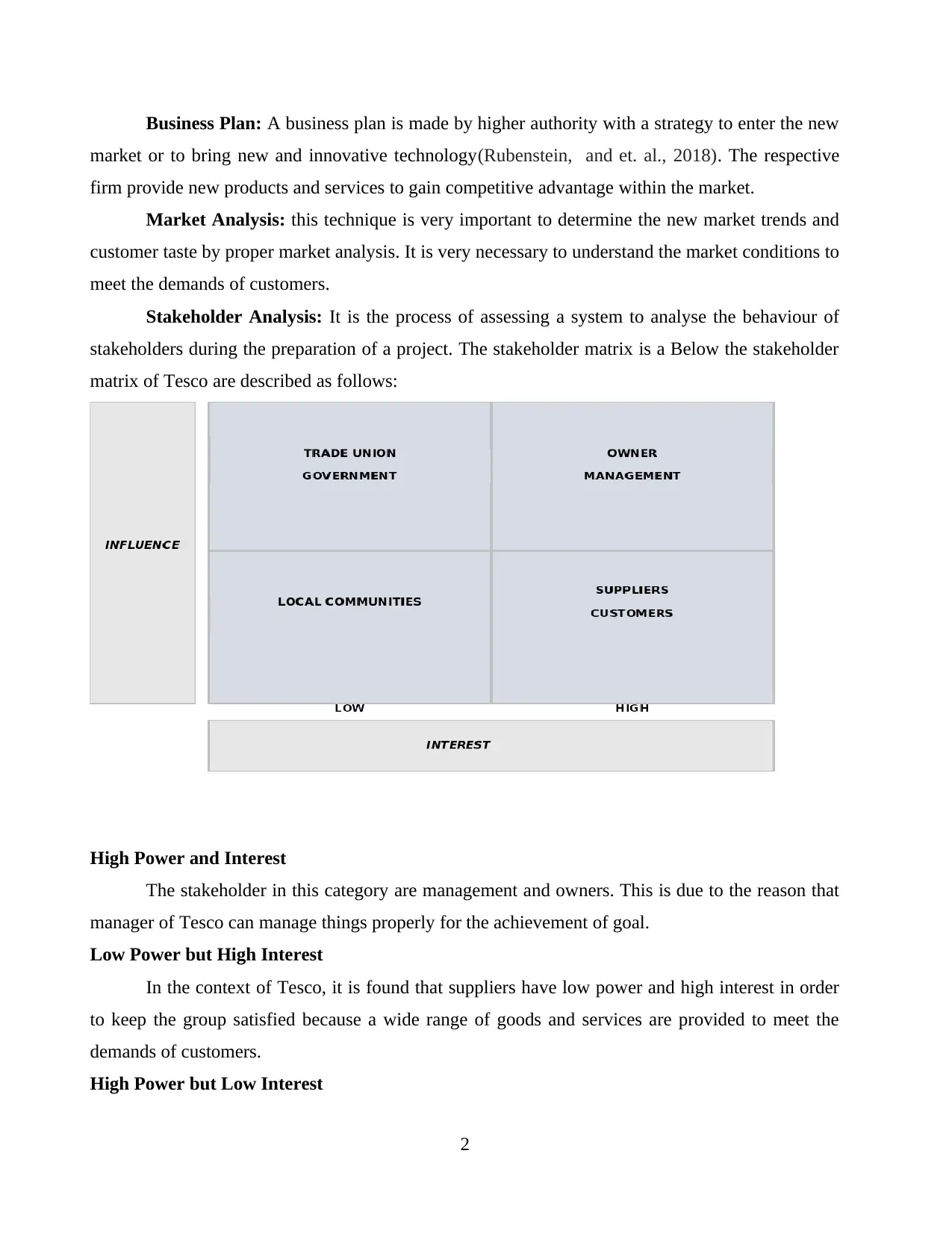
Business Plan: A business plan is made by higher authority with a strategy to enter the new
market or to bring new and innovative technology(Rubenstein, and et. al., 2018). The respective
firm provide new products and services to gain competitive advantage within the market.
Market Analysis: this technique is very important to determine the new market trends and
customer taste by proper market analysis. It is very necessary to understand the market conditions to
meet the demands of customers.
Stakeholder Analysis: It is the process of assessing a system to analyse the behaviour of
stakeholders during the preparation of a project. The stakeholder matrix is a Below the stakeholder
matrix of Tesco are described as follows:
High Power and Interest
The stakeholder in this category are management and owners. This is due to the reason that
manager of Tesco can manage things properly for the achievement of goal.
Low Power but High Interest
In the context of Tesco, it is found that suppliers have low power and high interest in order
to keep the group satisfied because a wide range of goods and services are provided to meet the
demands of customers.
High Power but Low Interest
2
market or to bring new and innovative technology(Rubenstein, and et. al., 2018). The respective
firm provide new products and services to gain competitive advantage within the market.
Market Analysis: this technique is very important to determine the new market trends and
customer taste by proper market analysis. It is very necessary to understand the market conditions to
meet the demands of customers.
Stakeholder Analysis: It is the process of assessing a system to analyse the behaviour of
stakeholders during the preparation of a project. The stakeholder matrix is a Below the stakeholder
matrix of Tesco are described as follows:
High Power and Interest
The stakeholder in this category are management and owners. This is due to the reason that
manager of Tesco can manage things properly for the achievement of goal.
Low Power but High Interest
In the context of Tesco, it is found that suppliers have low power and high interest in order
to keep the group satisfied because a wide range of goods and services are provided to meet the
demands of customers.
High Power but Low Interest
2
Paraphrase This Document
Need a fresh take? Get an instant paraphrase of this document with our AI Paraphraser
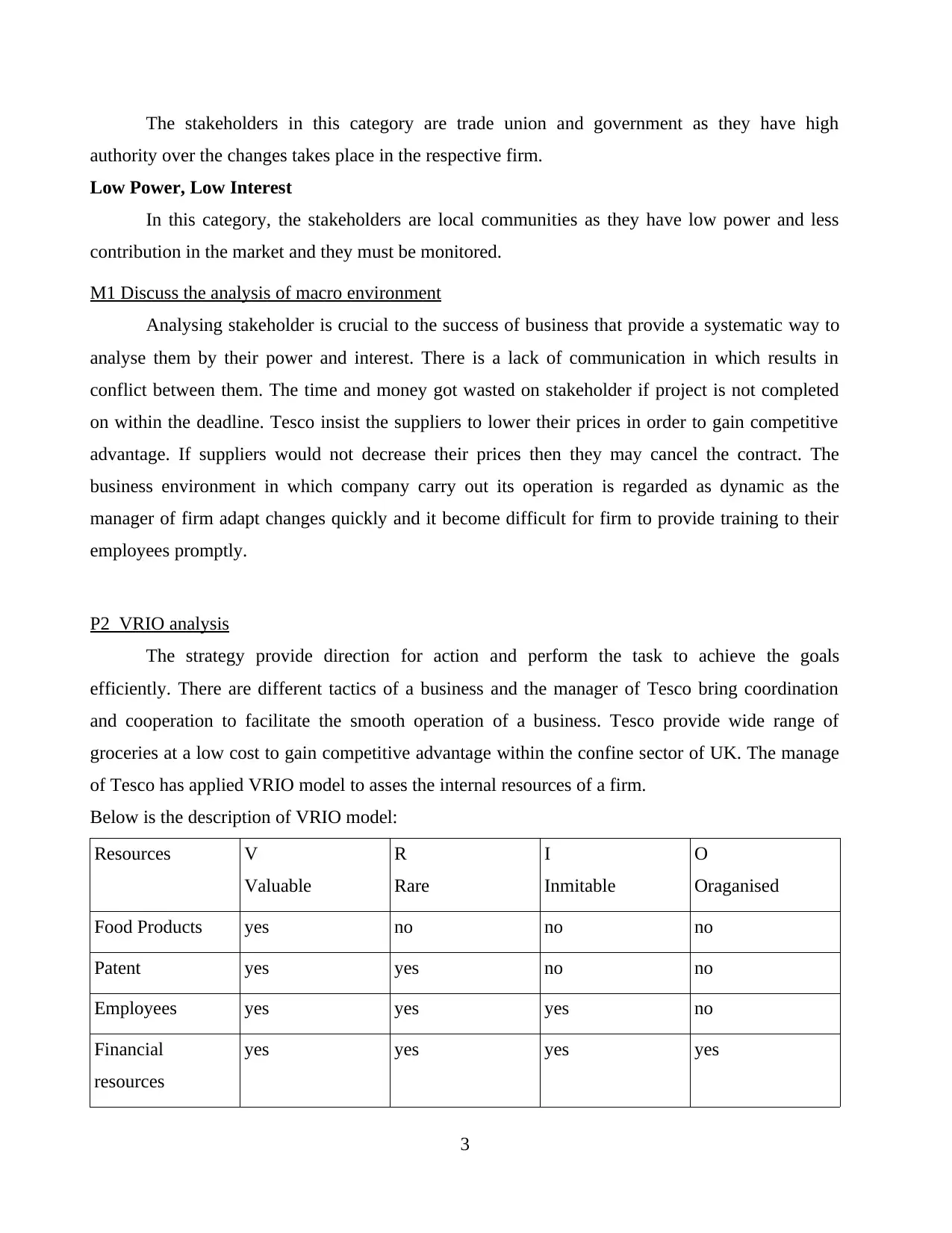
The stakeholders in this category are trade union and government as they have high
authority over the changes takes place in the respective firm.
Low Power, Low Interest
In this category, the stakeholders are local communities as they have low power and less
contribution in the market and they must be monitored.
M1 Discuss the analysis of macro environment
Analysing stakeholder is crucial to the success of business that provide a systematic way to
analyse them by their power and interest. There is a lack of communication in which results in
conflict between them. The time and money got wasted on stakeholder if project is not completed
on within the deadline. Tesco insist the suppliers to lower their prices in order to gain competitive
advantage. If suppliers would not decrease their prices then they may cancel the contract. The
business environment in which company carry out its operation is regarded as dynamic as the
manager of firm adapt changes quickly and it become difficult for firm to provide training to their
employees promptly.
P2 VRIO analysis
The strategy provide direction for action and perform the task to achieve the goals
efficiently. There are different tactics of a business and the manager of Tesco bring coordination
and cooperation to facilitate the smooth operation of a business. Tesco provide wide range of
groceries at a low cost to gain competitive advantage within the confine sector of UK. The manage
of Tesco has applied VRIO model to asses the internal resources of a firm.
Below is the description of VRIO model:
Resources V
Valuable
R
Rare
I
Inmitable
O
Oraganised
Food Products yes no no no
Patent yes yes no no
Employees yes yes yes no
Financial
resources
yes yes yes yes
3
authority over the changes takes place in the respective firm.
Low Power, Low Interest
In this category, the stakeholders are local communities as they have low power and less
contribution in the market and they must be monitored.
M1 Discuss the analysis of macro environment
Analysing stakeholder is crucial to the success of business that provide a systematic way to
analyse them by their power and interest. There is a lack of communication in which results in
conflict between them. The time and money got wasted on stakeholder if project is not completed
on within the deadline. Tesco insist the suppliers to lower their prices in order to gain competitive
advantage. If suppliers would not decrease their prices then they may cancel the contract. The
business environment in which company carry out its operation is regarded as dynamic as the
manager of firm adapt changes quickly and it become difficult for firm to provide training to their
employees promptly.
P2 VRIO analysis
The strategy provide direction for action and perform the task to achieve the goals
efficiently. There are different tactics of a business and the manager of Tesco bring coordination
and cooperation to facilitate the smooth operation of a business. Tesco provide wide range of
groceries at a low cost to gain competitive advantage within the confine sector of UK. The manage
of Tesco has applied VRIO model to asses the internal resources of a firm.
Below is the description of VRIO model:
Resources V
Valuable
R
Rare
I
Inmitable
O
Oraganised
Food Products yes no no no
Patent yes yes no no
Employees yes yes yes no
Financial
resources
yes yes yes yes
3
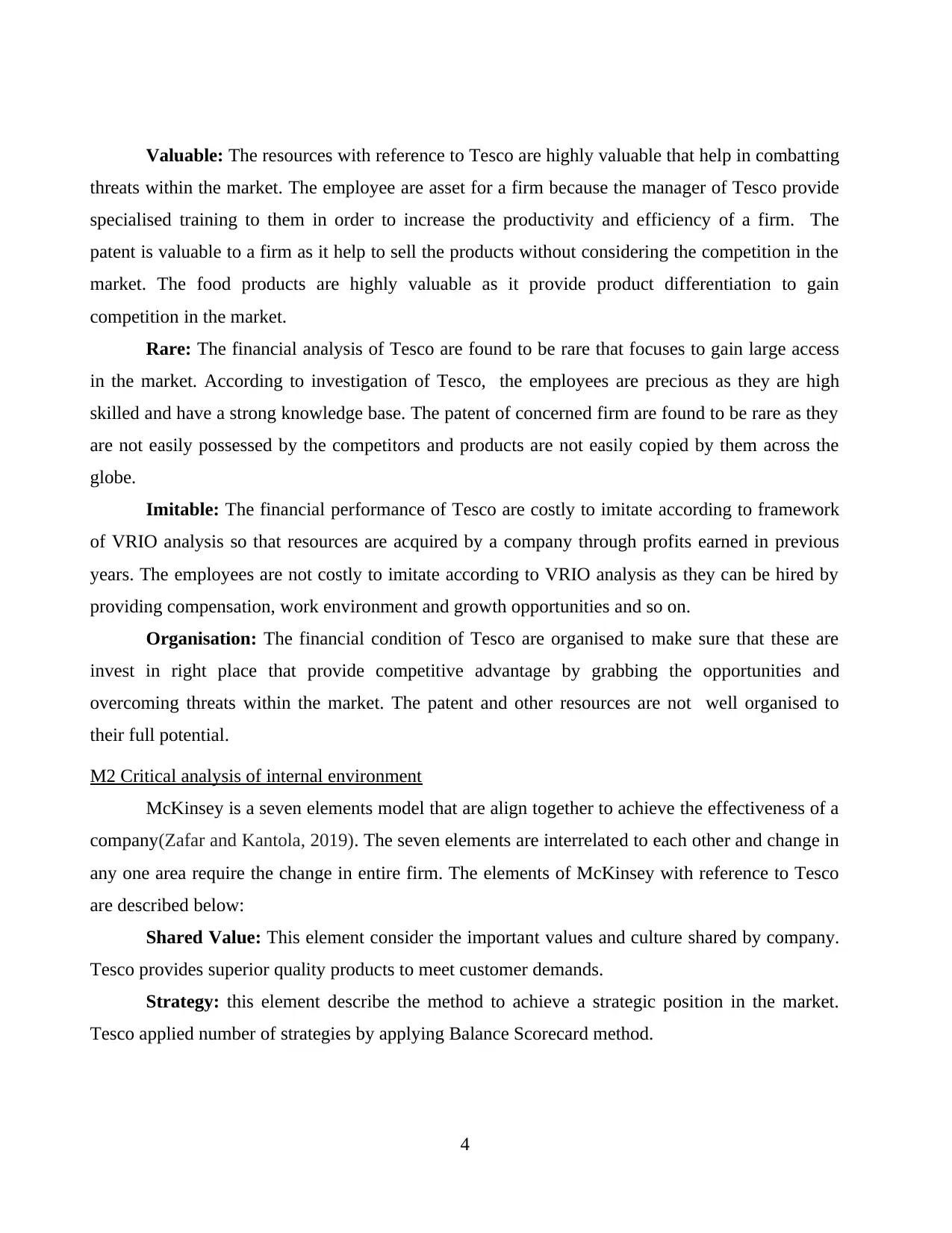
Valuable: The resources with reference to Tesco are highly valuable that help in combatting
threats within the market. The employee are asset for a firm because the manager of Tesco provide
specialised training to them in order to increase the productivity and efficiency of a firm. The
patent is valuable to a firm as it help to sell the products without considering the competition in the
market. The food products are highly valuable as it provide product differentiation to gain
competition in the market.
Rare: The financial analysis of Tesco are found to be rare that focuses to gain large access
in the market. According to investigation of Tesco, the employees are precious as they are high
skilled and have a strong knowledge base. The patent of concerned firm are found to be rare as they
are not easily possessed by the competitors and products are not easily copied by them across the
globe.
Imitable: The financial performance of Tesco are costly to imitate according to framework
of VRIO analysis so that resources are acquired by a company through profits earned in previous
years. The employees are not costly to imitate according to VRIO analysis as they can be hired by
providing compensation, work environment and growth opportunities and so on.
Organisation: The financial condition of Tesco are organised to make sure that these are
invest in right place that provide competitive advantage by grabbing the opportunities and
overcoming threats within the market. The patent and other resources are not well organised to
their full potential.
M2 Critical analysis of internal environment
McKinsey is a seven elements model that are align together to achieve the effectiveness of a
company(Zafar and Kantola, 2019). The seven elements are interrelated to each other and change in
any one area require the change in entire firm. The elements of McKinsey with reference to Tesco
are described below:
Shared Value: This element consider the important values and culture shared by company.
Tesco provides superior quality products to meet customer demands.
Strategy: this element describe the method to achieve a strategic position in the market.
Tesco applied number of strategies by applying Balance Scorecard method.
4
threats within the market. The employee are asset for a firm because the manager of Tesco provide
specialised training to them in order to increase the productivity and efficiency of a firm. The
patent is valuable to a firm as it help to sell the products without considering the competition in the
market. The food products are highly valuable as it provide product differentiation to gain
competition in the market.
Rare: The financial analysis of Tesco are found to be rare that focuses to gain large access
in the market. According to investigation of Tesco, the employees are precious as they are high
skilled and have a strong knowledge base. The patent of concerned firm are found to be rare as they
are not easily possessed by the competitors and products are not easily copied by them across the
globe.
Imitable: The financial performance of Tesco are costly to imitate according to framework
of VRIO analysis so that resources are acquired by a company through profits earned in previous
years. The employees are not costly to imitate according to VRIO analysis as they can be hired by
providing compensation, work environment and growth opportunities and so on.
Organisation: The financial condition of Tesco are organised to make sure that these are
invest in right place that provide competitive advantage by grabbing the opportunities and
overcoming threats within the market. The patent and other resources are not well organised to
their full potential.
M2 Critical analysis of internal environment
McKinsey is a seven elements model that are align together to achieve the effectiveness of a
company(Zafar and Kantola, 2019). The seven elements are interrelated to each other and change in
any one area require the change in entire firm. The elements of McKinsey with reference to Tesco
are described below:
Shared Value: This element consider the important values and culture shared by company.
Tesco provides superior quality products to meet customer demands.
Strategy: this element describe the method to achieve a strategic position in the market.
Tesco applied number of strategies by applying Balance Scorecard method.
4
⊘ This is a preview!⊘
Do you want full access?
Subscribe today to unlock all pages.

Trusted by 1+ million students worldwide
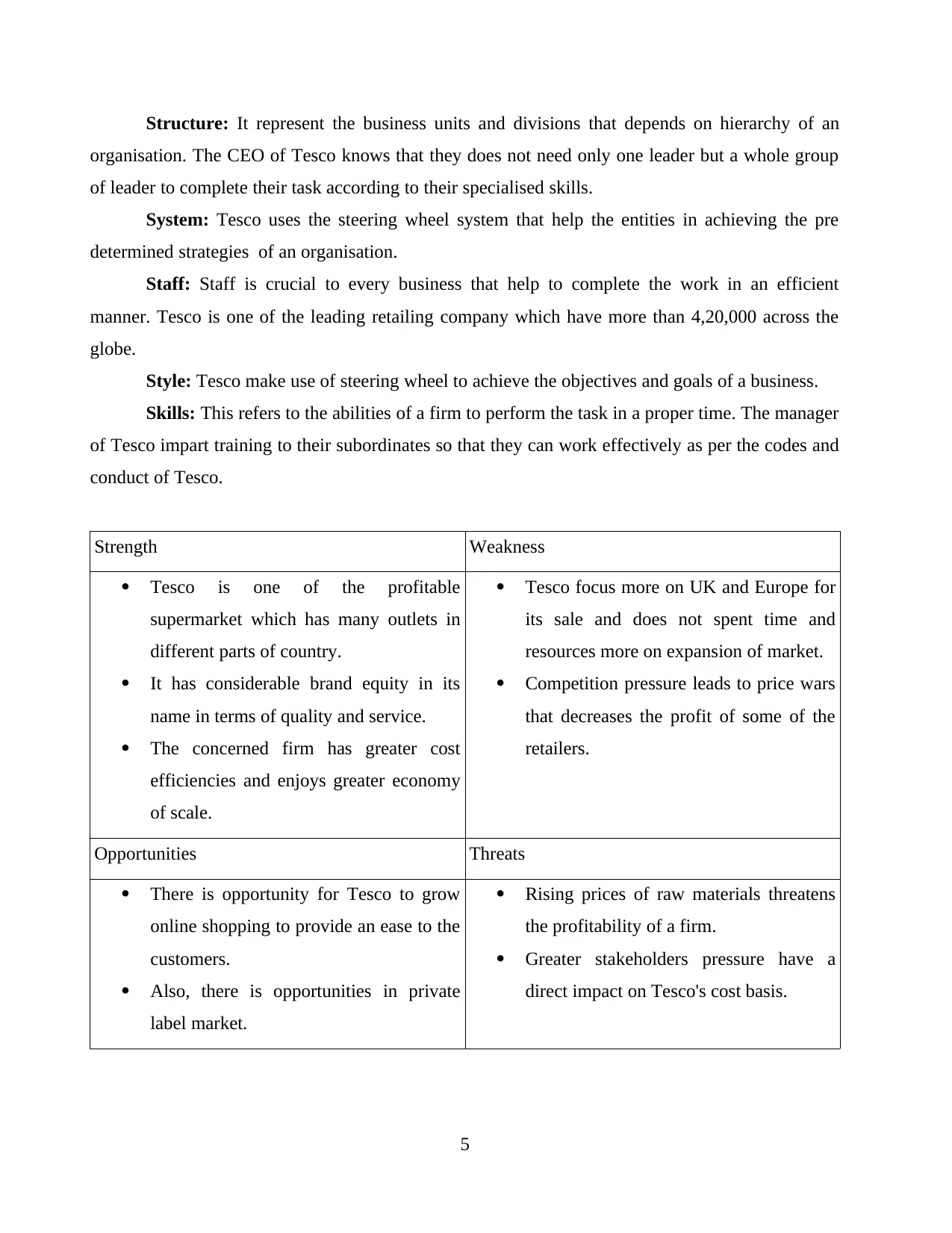
Structure: It represent the business units and divisions that depends on hierarchy of an
organisation. The CEO of Tesco knows that they does not need only one leader but a whole group
of leader to complete their task according to their specialised skills.
System: Tesco uses the steering wheel system that help the entities in achieving the pre
determined strategies of an organisation.
Staff: Staff is crucial to every business that help to complete the work in an efficient
manner. Tesco is one of the leading retailing company which have more than 4,20,000 across the
globe.
Style: Tesco make use of steering wheel to achieve the objectives and goals of a business.
Skills: This refers to the abilities of a firm to perform the task in a proper time. The manager
of Tesco impart training to their subordinates so that they can work effectively as per the codes and
conduct of Tesco.
Strength Weakness
Tesco is one of the profitable
supermarket which has many outlets in
different parts of country.
It has considerable brand equity in its
name in terms of quality and service.
The concerned firm has greater cost
efficiencies and enjoys greater economy
of scale.
Tesco focus more on UK and Europe for
its sale and does not spent time and
resources more on expansion of market.
Competition pressure leads to price wars
that decreases the profit of some of the
retailers.
Opportunities Threats
There is opportunity for Tesco to grow
online shopping to provide an ease to the
customers.
Also, there is opportunities in private
label market.
Rising prices of raw materials threatens
the profitability of a firm.
Greater stakeholders pressure have a
direct impact on Tesco's cost basis.
5
organisation. The CEO of Tesco knows that they does not need only one leader but a whole group
of leader to complete their task according to their specialised skills.
System: Tesco uses the steering wheel system that help the entities in achieving the pre
determined strategies of an organisation.
Staff: Staff is crucial to every business that help to complete the work in an efficient
manner. Tesco is one of the leading retailing company which have more than 4,20,000 across the
globe.
Style: Tesco make use of steering wheel to achieve the objectives and goals of a business.
Skills: This refers to the abilities of a firm to perform the task in a proper time. The manager
of Tesco impart training to their subordinates so that they can work effectively as per the codes and
conduct of Tesco.
Strength Weakness
Tesco is one of the profitable
supermarket which has many outlets in
different parts of country.
It has considerable brand equity in its
name in terms of quality and service.
The concerned firm has greater cost
efficiencies and enjoys greater economy
of scale.
Tesco focus more on UK and Europe for
its sale and does not spent time and
resources more on expansion of market.
Competition pressure leads to price wars
that decreases the profit of some of the
retailers.
Opportunities Threats
There is opportunity for Tesco to grow
online shopping to provide an ease to the
customers.
Also, there is opportunities in private
label market.
Rising prices of raw materials threatens
the profitability of a firm.
Greater stakeholders pressure have a
direct impact on Tesco's cost basis.
5
Paraphrase This Document
Need a fresh take? Get an instant paraphrase of this document with our AI Paraphraser
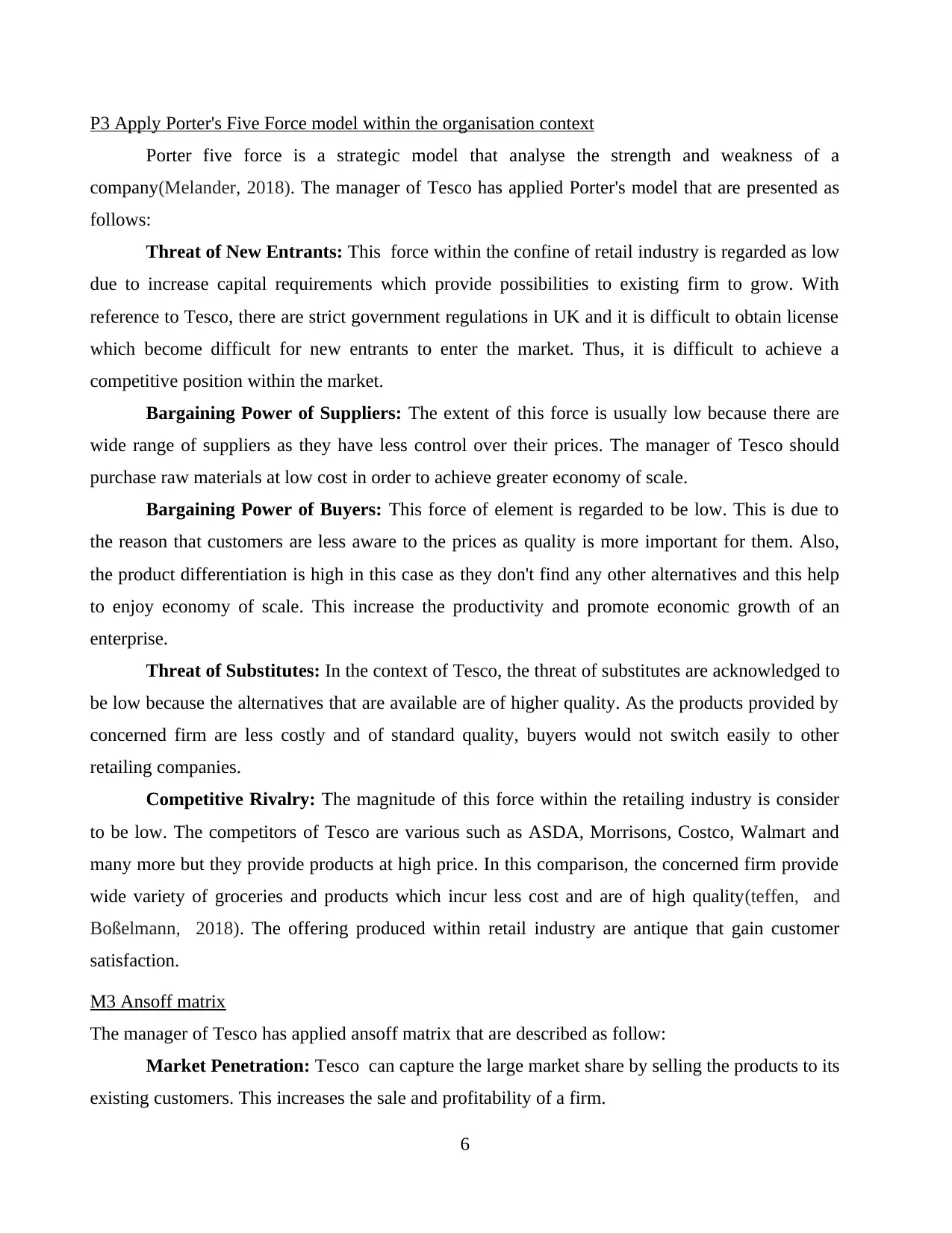
P3 Apply Porter's Five Force model within the organisation context
Porter five force is a strategic model that analyse the strength and weakness of a
company(Melander, 2018). The manager of Tesco has applied Porter's model that are presented as
follows:
Threat of New Entrants: This force within the confine of retail industry is regarded as low
due to increase capital requirements which provide possibilities to existing firm to grow. With
reference to Tesco, there are strict government regulations in UK and it is difficult to obtain license
which become difficult for new entrants to enter the market. Thus, it is difficult to achieve a
competitive position within the market.
Bargaining Power of Suppliers: The extent of this force is usually low because there are
wide range of suppliers as they have less control over their prices. The manager of Tesco should
purchase raw materials at low cost in order to achieve greater economy of scale.
Bargaining Power of Buyers: This force of element is regarded to be low. This is due to
the reason that customers are less aware to the prices as quality is more important for them. Also,
the product differentiation is high in this case as they don't find any other alternatives and this help
to enjoy economy of scale. This increase the productivity and promote economic growth of an
enterprise.
Threat of Substitutes: In the context of Tesco, the threat of substitutes are acknowledged to
be low because the alternatives that are available are of higher quality. As the products provided by
concerned firm are less costly and of standard quality, buyers would not switch easily to other
retailing companies.
Competitive Rivalry: The magnitude of this force within the retailing industry is consider
to be low. The competitors of Tesco are various such as ASDA, Morrisons, Costco, Walmart and
many more but they provide products at high price. In this comparison, the concerned firm provide
wide variety of groceries and products which incur less cost and are of high quality(teffen, and
Boßelmann, 2018). The offering produced within retail industry are antique that gain customer
satisfaction.
M3 Ansoff matrix
The manager of Tesco has applied ansoff matrix that are described as follow:
Market Penetration: Tesco can capture the large market share by selling the products to its
existing customers. This increases the sale and profitability of a firm.
6
Porter five force is a strategic model that analyse the strength and weakness of a
company(Melander, 2018). The manager of Tesco has applied Porter's model that are presented as
follows:
Threat of New Entrants: This force within the confine of retail industry is regarded as low
due to increase capital requirements which provide possibilities to existing firm to grow. With
reference to Tesco, there are strict government regulations in UK and it is difficult to obtain license
which become difficult for new entrants to enter the market. Thus, it is difficult to achieve a
competitive position within the market.
Bargaining Power of Suppliers: The extent of this force is usually low because there are
wide range of suppliers as they have less control over their prices. The manager of Tesco should
purchase raw materials at low cost in order to achieve greater economy of scale.
Bargaining Power of Buyers: This force of element is regarded to be low. This is due to
the reason that customers are less aware to the prices as quality is more important for them. Also,
the product differentiation is high in this case as they don't find any other alternatives and this help
to enjoy economy of scale. This increase the productivity and promote economic growth of an
enterprise.
Threat of Substitutes: In the context of Tesco, the threat of substitutes are acknowledged to
be low because the alternatives that are available are of higher quality. As the products provided by
concerned firm are less costly and of standard quality, buyers would not switch easily to other
retailing companies.
Competitive Rivalry: The magnitude of this force within the retailing industry is consider
to be low. The competitors of Tesco are various such as ASDA, Morrisons, Costco, Walmart and
many more but they provide products at high price. In this comparison, the concerned firm provide
wide variety of groceries and products which incur less cost and are of high quality(teffen, and
Boßelmann, 2018). The offering produced within retail industry are antique that gain customer
satisfaction.
M3 Ansoff matrix
The manager of Tesco has applied ansoff matrix that are described as follow:
Market Penetration: Tesco can capture the large market share by selling the products to its
existing customers. This increases the sale and profitability of a firm.
6
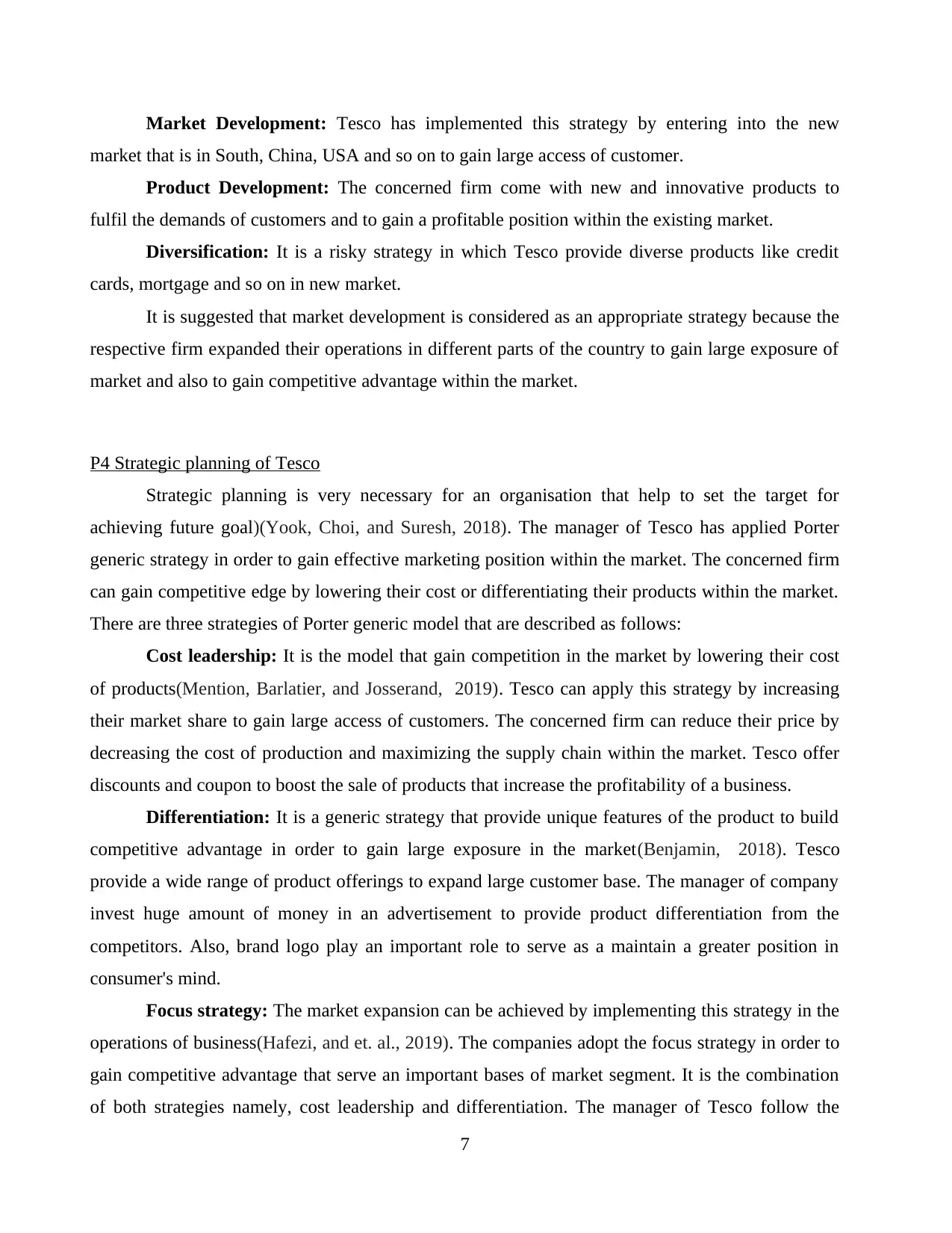
Market Development: Tesco has implemented this strategy by entering into the new
market that is in South, China, USA and so on to gain large access of customer.
Product Development: The concerned firm come with new and innovative products to
fulfil the demands of customers and to gain a profitable position within the existing market.
Diversification: It is a risky strategy in which Tesco provide diverse products like credit
cards, mortgage and so on in new market.
It is suggested that market development is considered as an appropriate strategy because the
respective firm expanded their operations in different parts of the country to gain large exposure of
market and also to gain competitive advantage within the market.
P4 Strategic planning of Tesco
Strategic planning is very necessary for an organisation that help to set the target for
achieving future goal)(Yook, Choi, and Suresh, 2018). The manager of Tesco has applied Porter
generic strategy in order to gain effective marketing position within the market. The concerned firm
can gain competitive edge by lowering their cost or differentiating their products within the market.
There are three strategies of Porter generic model that are described as follows:
Cost leadership: It is the model that gain competition in the market by lowering their cost
of products(Mention, Barlatier, and Josserand, 2019). Tesco can apply this strategy by increasing
their market share to gain large access of customers. The concerned firm can reduce their price by
decreasing the cost of production and maximizing the supply chain within the market. Tesco offer
discounts and coupon to boost the sale of products that increase the profitability of a business.
Differentiation: It is a generic strategy that provide unique features of the product to build
competitive advantage in order to gain large exposure in the market(Benjamin, 2018). Tesco
provide a wide range of product offerings to expand large customer base. The manager of company
invest huge amount of money in an advertisement to provide product differentiation from the
competitors. Also, brand logo play an important role to serve as a maintain a greater position in
consumer's mind.
Focus strategy: The market expansion can be achieved by implementing this strategy in the
operations of business(Hafezi, and et. al., 2019). The companies adopt the focus strategy in order to
gain competitive advantage that serve an important bases of market segment. It is the combination
of both strategies namely, cost leadership and differentiation. The manager of Tesco follow the
7
market that is in South, China, USA and so on to gain large access of customer.
Product Development: The concerned firm come with new and innovative products to
fulfil the demands of customers and to gain a profitable position within the existing market.
Diversification: It is a risky strategy in which Tesco provide diverse products like credit
cards, mortgage and so on in new market.
It is suggested that market development is considered as an appropriate strategy because the
respective firm expanded their operations in different parts of the country to gain large exposure of
market and also to gain competitive advantage within the market.
P4 Strategic planning of Tesco
Strategic planning is very necessary for an organisation that help to set the target for
achieving future goal)(Yook, Choi, and Suresh, 2018). The manager of Tesco has applied Porter
generic strategy in order to gain effective marketing position within the market. The concerned firm
can gain competitive edge by lowering their cost or differentiating their products within the market.
There are three strategies of Porter generic model that are described as follows:
Cost leadership: It is the model that gain competition in the market by lowering their cost
of products(Mention, Barlatier, and Josserand, 2019). Tesco can apply this strategy by increasing
their market share to gain large access of customers. The concerned firm can reduce their price by
decreasing the cost of production and maximizing the supply chain within the market. Tesco offer
discounts and coupon to boost the sale of products that increase the profitability of a business.
Differentiation: It is a generic strategy that provide unique features of the product to build
competitive advantage in order to gain large exposure in the market(Benjamin, 2018). Tesco
provide a wide range of product offerings to expand large customer base. The manager of company
invest huge amount of money in an advertisement to provide product differentiation from the
competitors. Also, brand logo play an important role to serve as a maintain a greater position in
consumer's mind.
Focus strategy: The market expansion can be achieved by implementing this strategy in the
operations of business(Hafezi, and et. al., 2019). The companies adopt the focus strategy in order to
gain competitive advantage that serve an important bases of market segment. It is the combination
of both strategies namely, cost leadership and differentiation. The manager of Tesco follow the
7
⊘ This is a preview!⊘
Do you want full access?
Subscribe today to unlock all pages.

Trusted by 1+ million students worldwide
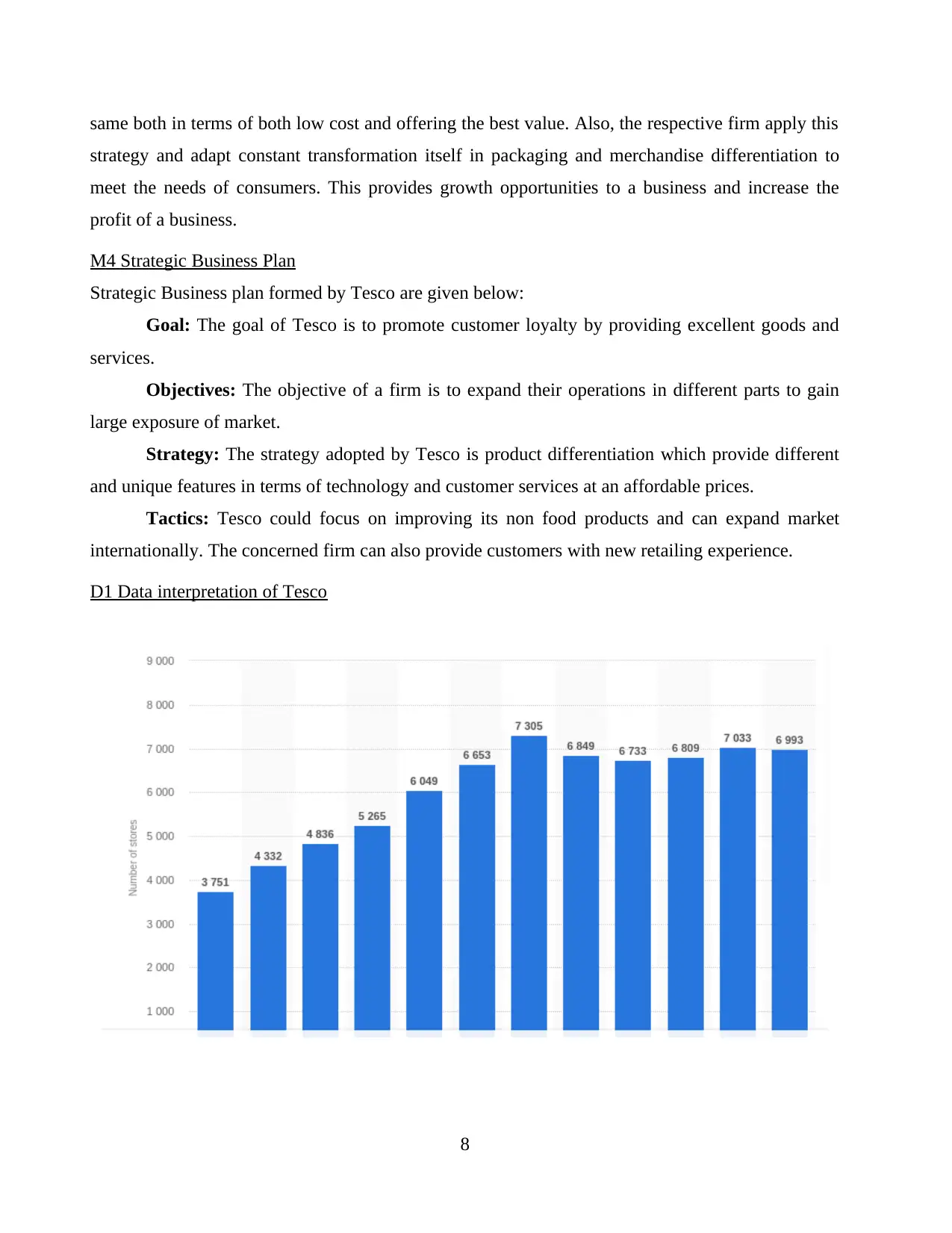
same both in terms of both low cost and offering the best value. Also, the respective firm apply this
strategy and adapt constant transformation itself in packaging and merchandise differentiation to
meet the needs of consumers. This provides growth opportunities to a business and increase the
profit of a business.
M4 Strategic Business Plan
Strategic Business plan formed by Tesco are given below:
Goal: The goal of Tesco is to promote customer loyalty by providing excellent goods and
services.
Objectives: The objective of a firm is to expand their operations in different parts to gain
large exposure of market.
Strategy: The strategy adopted by Tesco is product differentiation which provide different
and unique features in terms of technology and customer services at an affordable prices.
Tactics: Tesco could focus on improving its non food products and can expand market
internationally. The concerned firm can also provide customers with new retailing experience.
D1 Data interpretation of Tesco
8
strategy and adapt constant transformation itself in packaging and merchandise differentiation to
meet the needs of consumers. This provides growth opportunities to a business and increase the
profit of a business.
M4 Strategic Business Plan
Strategic Business plan formed by Tesco are given below:
Goal: The goal of Tesco is to promote customer loyalty by providing excellent goods and
services.
Objectives: The objective of a firm is to expand their operations in different parts to gain
large exposure of market.
Strategy: The strategy adopted by Tesco is product differentiation which provide different
and unique features in terms of technology and customer services at an affordable prices.
Tactics: Tesco could focus on improving its non food products and can expand market
internationally. The concerned firm can also provide customers with new retailing experience.
D1 Data interpretation of Tesco
8
Paraphrase This Document
Need a fresh take? Get an instant paraphrase of this document with our AI Paraphraser
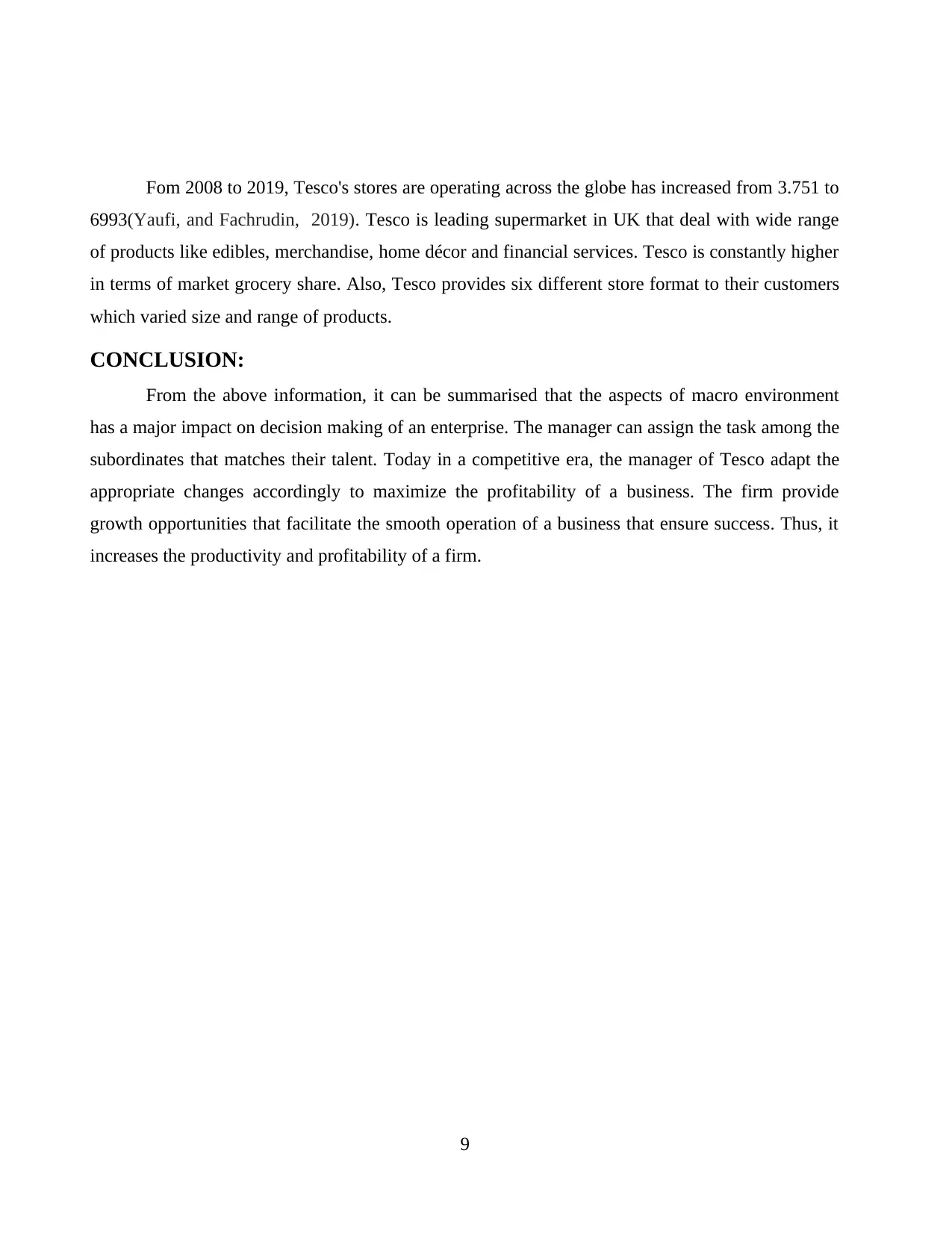
Fom 2008 to 2019, Tesco's stores are operating across the globe has increased from 3.751 to
6993(Yaufi, and Fachrudin, 2019). Tesco is leading supermarket in UK that deal with wide range
of products like edibles, merchandise, home décor and financial services. Tesco is constantly higher
in terms of market grocery share. Also, Tesco provides six different store format to their customers
which varied size and range of products.
CONCLUSION:
From the above information, it can be summarised that the aspects of macro environment
has a major impact on decision making of an enterprise. The manager can assign the task among the
subordinates that matches their talent. Today in a competitive era, the manager of Tesco adapt the
appropriate changes accordingly to maximize the profitability of a business. The firm provide
growth opportunities that facilitate the smooth operation of a business that ensure success. Thus, it
increases the productivity and profitability of a firm.
9
6993(Yaufi, and Fachrudin, 2019). Tesco is leading supermarket in UK that deal with wide range
of products like edibles, merchandise, home décor and financial services. Tesco is constantly higher
in terms of market grocery share. Also, Tesco provides six different store format to their customers
which varied size and range of products.
CONCLUSION:
From the above information, it can be summarised that the aspects of macro environment
has a major impact on decision making of an enterprise. The manager can assign the task among the
subordinates that matches their talent. Today in a competitive era, the manager of Tesco adapt the
appropriate changes accordingly to maximize the profitability of a business. The firm provide
growth opportunities that facilitate the smooth operation of a business that ensure success. Thus, it
increases the productivity and profitability of a firm.
9
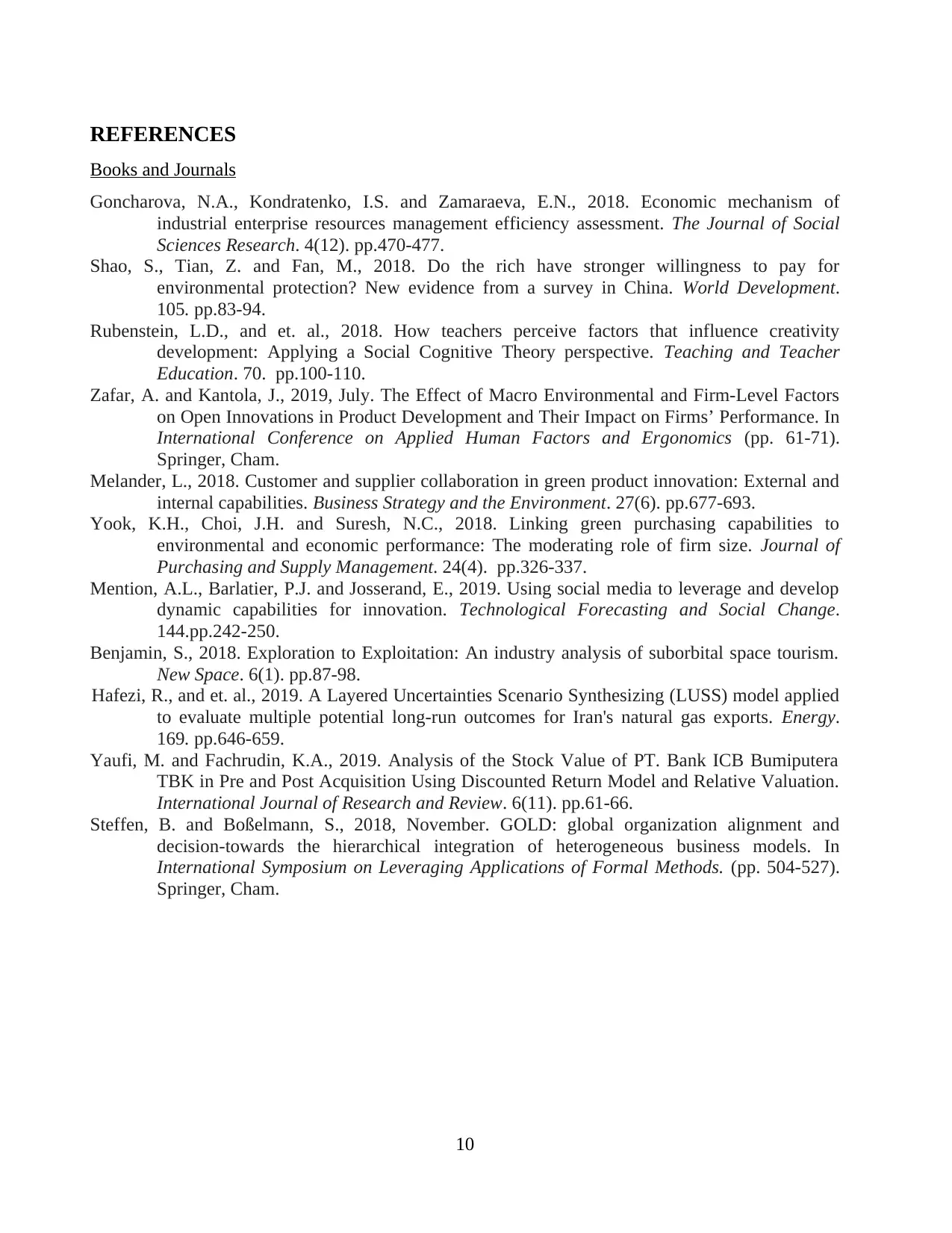
REFERENCES
Books and Journals
Goncharova, N.A., Kondratenko, I.S. and Zamaraeva, E.N., 2018. Economic mechanism of
industrial enterprise resources management efficiency assessment. The Journal of Social
Sciences Research. 4(12). pp.470-477.
Shao, S., Tian, Z. and Fan, M., 2018. Do the rich have stronger willingness to pay for
environmental protection? New evidence from a survey in China. World Development.
105. pp.83-94.
Rubenstein, L.D., and et. al., 2018. How teachers perceive factors that influence creativity
development: Applying a Social Cognitive Theory perspective. Teaching and Teacher
Education. 70. pp.100-110.
Zafar, A. and Kantola, J., 2019, July. The Effect of Macro Environmental and Firm-Level Factors
on Open Innovations in Product Development and Their Impact on Firms’ Performance. In
International Conference on Applied Human Factors and Ergonomics (pp. 61-71).
Springer, Cham.
Melander, L., 2018. Customer and supplier collaboration in green product innovation: External and
internal capabilities. Business Strategy and the Environment. 27(6). pp.677-693.
Yook, K.H., Choi, J.H. and Suresh, N.C., 2018. Linking green purchasing capabilities to
environmental and economic performance: The moderating role of firm size. Journal of
Purchasing and Supply Management. 24(4). pp.326-337.
Mention, A.L., Barlatier, P.J. and Josserand, E., 2019. Using social media to leverage and develop
dynamic capabilities for innovation. Technological Forecasting and Social Change.
144.pp.242-250.
Benjamin, S., 2018. Exploration to Exploitation: An industry analysis of suborbital space tourism.
New Space. 6(1). pp.87-98.
Hafezi, R., and et. al., 2019. A Layered Uncertainties Scenario Synthesizing (LUSS) model applied
to evaluate multiple potential long-run outcomes for Iran's natural gas exports. Energy.
169. pp.646-659.
Yaufi, M. and Fachrudin, K.A., 2019. Analysis of the Stock Value of PT. Bank ICB Bumiputera
TBK in Pre and Post Acquisition Using Discounted Return Model and Relative Valuation.
International Journal of Research and Review. 6(11). pp.61-66.
Steffen, B. and Boßelmann, S., 2018, November. GOLD: global organization alignment and
decision-towards the hierarchical integration of heterogeneous business models. In
International Symposium on Leveraging Applications of Formal Methods. (pp. 504-527).
Springer, Cham.
10
Books and Journals
Goncharova, N.A., Kondratenko, I.S. and Zamaraeva, E.N., 2018. Economic mechanism of
industrial enterprise resources management efficiency assessment. The Journal of Social
Sciences Research. 4(12). pp.470-477.
Shao, S., Tian, Z. and Fan, M., 2018. Do the rich have stronger willingness to pay for
environmental protection? New evidence from a survey in China. World Development.
105. pp.83-94.
Rubenstein, L.D., and et. al., 2018. How teachers perceive factors that influence creativity
development: Applying a Social Cognitive Theory perspective. Teaching and Teacher
Education. 70. pp.100-110.
Zafar, A. and Kantola, J., 2019, July. The Effect of Macro Environmental and Firm-Level Factors
on Open Innovations in Product Development and Their Impact on Firms’ Performance. In
International Conference on Applied Human Factors and Ergonomics (pp. 61-71).
Springer, Cham.
Melander, L., 2018. Customer and supplier collaboration in green product innovation: External and
internal capabilities. Business Strategy and the Environment. 27(6). pp.677-693.
Yook, K.H., Choi, J.H. and Suresh, N.C., 2018. Linking green purchasing capabilities to
environmental and economic performance: The moderating role of firm size. Journal of
Purchasing and Supply Management. 24(4). pp.326-337.
Mention, A.L., Barlatier, P.J. and Josserand, E., 2019. Using social media to leverage and develop
dynamic capabilities for innovation. Technological Forecasting and Social Change.
144.pp.242-250.
Benjamin, S., 2018. Exploration to Exploitation: An industry analysis of suborbital space tourism.
New Space. 6(1). pp.87-98.
Hafezi, R., and et. al., 2019. A Layered Uncertainties Scenario Synthesizing (LUSS) model applied
to evaluate multiple potential long-run outcomes for Iran's natural gas exports. Energy.
169. pp.646-659.
Yaufi, M. and Fachrudin, K.A., 2019. Analysis of the Stock Value of PT. Bank ICB Bumiputera
TBK in Pre and Post Acquisition Using Discounted Return Model and Relative Valuation.
International Journal of Research and Review. 6(11). pp.61-66.
Steffen, B. and Boßelmann, S., 2018, November. GOLD: global organization alignment and
decision-towards the hierarchical integration of heterogeneous business models. In
International Symposium on Leveraging Applications of Formal Methods. (pp. 504-527).
Springer, Cham.
10
⊘ This is a preview!⊘
Do you want full access?
Subscribe today to unlock all pages.

Trusted by 1+ million students worldwide
1 out of 12
Related Documents
Your All-in-One AI-Powered Toolkit for Academic Success.
+13062052269
info@desklib.com
Available 24*7 on WhatsApp / Email
![[object Object]](/_next/static/media/star-bottom.7253800d.svg)
Unlock your academic potential
Copyright © 2020–2025 A2Z Services. All Rights Reserved. Developed and managed by ZUCOL.





